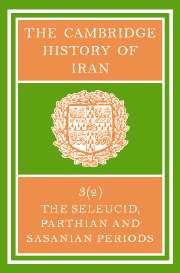Book contents
- Frontmatter
- PART 5 INSTITUTIONS
- PART 6 RELIGIOUS HISTORY
- 22 DEVELOPMENT OF RELIGIOUS THOUGHT
- 23 ZOROASTRIAN RELIGION
- 24 JEWS IN IRAN
- 25 CHRISTIANS IN IRAN
- 26 BUDDHISM AMONG IRANIAN PEOPLES
- 27(a) MANICHAEISM AND ITS IRANIAN BACKGROUND
- (b) MAZDAKISM
- PART 7 ART HISTORY
- PART 8 LANGUAGES AND LITERATURE
- PART 9 BIBLIOGRAPHY
- Bibliography
- Index
- Index of Greek words
- References
27(a) - MANICHAEISM AND ITS IRANIAN BACKGROUND
from PART 6 - RELIGIOUS HISTORY
Published online by Cambridge University Press: 28 March 2008
- Frontmatter
- PART 5 INSTITUTIONS
- PART 6 RELIGIOUS HISTORY
- 22 DEVELOPMENT OF RELIGIOUS THOUGHT
- 23 ZOROASTRIAN RELIGION
- 24 JEWS IN IRAN
- 25 CHRISTIANS IN IRAN
- 26 BUDDHISM AMONG IRANIAN PEOPLES
- 27(a) MANICHAEISM AND ITS IRANIAN BACKGROUND
- (b) MAZDAKISM
- PART 7 ART HISTORY
- PART 8 LANGUAGES AND LITERATURE
- PART 9 BIBLIOGRAPHY
- Bibliography
- Index
- Index of Greek words
- References
Summary
MĀNĪ'S LIFE
Mānī, the founder of Manichaeism, was born in a.d. 216 in the village of Mardinu in the Babylonian district of Nahr Kūthā. His parents, however, were both of Iranian nationality. His father Pātik was an Arsacid prince, his mother belonged to the Kamsarakan family, a branch of the Arsacid dynasty. His mother's name is given in various ways in the sources, but may possibly have been Maryam which would indicate that she was either of Jewish, or more probably, Christian confession. Pātik, who had been living in Hamadān, the capital of Media, had left this city and moved to Seleucia-Ctesiphon, the capital of the Parthian empire where many Iranian nobles possessed houses and palaces. Because of a revelation which he received in what is called a “House of idols”, ordering him to abstain from eating meat, drinking wine, and having commerce with women, Pātik left the capital and attached himself to a sect in Mesene whose members were called “practitioners of ablutions” (al-wughtasila).
It is difficult to identify the sect to which Pātik belonged. The Syriac writer Theodor bar Kōnai designates its members as “those who purify themselves” or as “(wearing) white garments”. The Manichaean writings in Coptic tell us that Mani says that “the chaste”, who are the same as “the baptizers”, venerate the First Life and the Second Life. The text then breaks off, but there is a remarkable coincidence here with the oldest layer of Mandean literature, where we find, as designations of the three highest principles, the First Life, the Second Life, and the Third Life.
- Type
- Chapter
- Information
- The Cambridge History of IranSeleucid Parthian, pp. 965 - 990Publisher: Cambridge University PressPrint publication year: 1983
References
- 1
- Cited by



